C.M. Rosens's Blog, page 30
May 7, 2022
Dragons and Dragon Folklore in South East England and the West Country (#MonstrousMay Day 7)
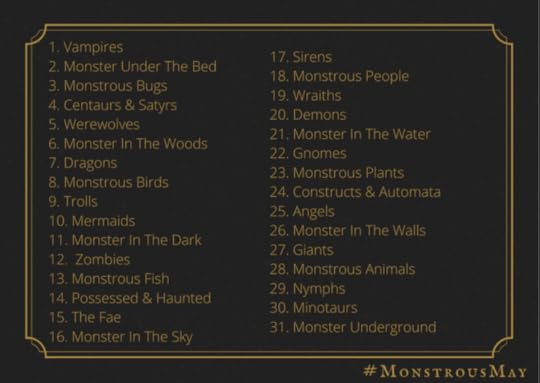 Prompts and Graphic Credit: Johannes T. Evans
Prompts and Graphic Credit: Johannes T. EvansThis is PART 4 of today’s mini-series of dragon posts!
PART 1: Wales and the Welsh Borders
PART 2: The North Country (including Scotland and the Islands)
PART 3: The Midlands and East Anglia
Here we go with London, the South East, and the West Country! This is the final part, as I’m all dragon’d out.
LondonLondon gets left out because it’s its own thing, but dragons rarely trouble London. They are, in fact, guarding the city, and here’s a map of them all!
The South East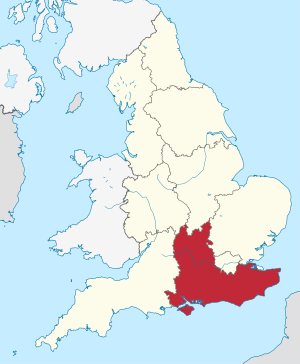 Map showing what counties constitute “the South East”Dragon Hill: the St George legend has been adapted to take the saint out of his native Turkey and have him rock up in the village of Uffington, where he kills his famous dragon. Here’s more on the nearby White Horse!
Map showing what counties constitute “the South East”Dragon Hill: the St George legend has been adapted to take the saint out of his native Turkey and have him rock up in the village of Uffington, where he kills his famous dragon. Here’s more on the nearby White Horse! The Essex Serpent : Yes, this has inspired a novel, and is based on the sightings of a flying serpent who reportedly troubled the people of Henham and Saffron Walden.
Alison Barnes, a freelance writer and broadcaster, is sure that this was a hoax perpetrated by the ingenious William Winstanley and his nephew Henry in 1668 by constructing it out of wood and fabric, and then wrote a pamphlet in 1669 with 7 close friends of his all swearing to the veracity of the sightings.
The New Forest, Hampshire has dragon stories all around the fringes of it, including the Bisterne dragon, slain by Sir Maurice Berkeley in the 15thC, who covered his armour with bird lime and broken glass to do battle with the beast (reminscent of Sir John Lambton’s spiked armour with which he defeated the Lambton worm). This story plays more with the idea of the dragon as connected to the Devil, and a creature possessed by evil.
It is said in some versions of the tale that Sir Maurice was haunted by nightmares and driven mad after killing it, so that he went back to the spot where the battle between them took place, laid down, and died there.
Other villages on the south-western fringe have dragon stories too: Michael O’Leary’s book, Folktales of Hampshire and the Isle of Wight, lists the villages of Sway, Durns Town, Birchy Hill, Golden Hill, Ashley, Bashley, Tiptoe and Hordle. There are smugglers’ tunnels through some of these villages, so it’s possible that the dragon stories were to keep inquisitive people away while the smugglers did their work!
West Sussex is absolutely riddled with their own brand of creature: knuckers, from OE nicor, meaning serpent. They live – guess where? In pools of water… and in West Sussex, ‘knucker holes’ have other kinds of lore attached to them too, like they’re bottomless, or go down to the ends of the earth…
You can read about Sussex and its dragon lore here.
You’ll find stories like the Lyminster Dragon, the dragon of Bignor Hill, the serpent of St Leonard’s Forest, and the knuckers of Sompting and Binsted. For some reason there’s a real concentration of stories in this part of the county – west, not east.
What I kind of love about the Sussex stories is that knights don’t kill the knuckers, the locals do it themselves with things like poisoned pies. I’d love to do a map of all the knights vs the local peasantry/lower gentry farmers who just get on with it, and see what the spread of tales are and which are most popular in what counties. One day. West Country
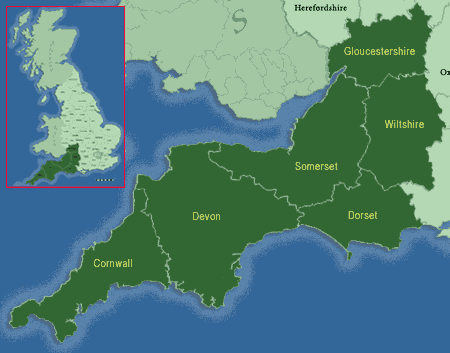 Counties of the West Country
Counties of the West Country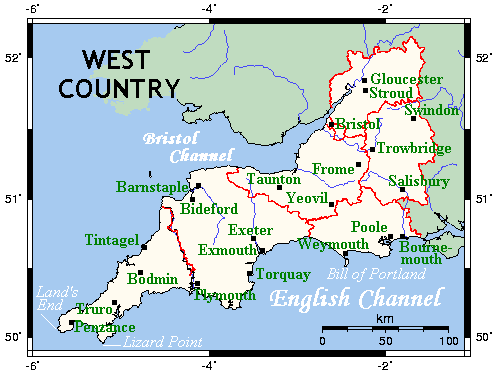 The West Country
The West CountryI covered Gloucestershire in the Welsh Borders post (PART 1), I think, but I can always circle back and add things in if I missed it out!
Note that Cornwall is another Brythonic-speaking region, and you can find out more about the Cornish language here. There is definitely a Beast of Bodmin, but it’s not a dragon! There are far less dragons in Cornwall than in other areas: this post posits a few suggestions why.
Let’s start with Somerset, because the dragon was the symbol of Wessex (the West Saxons) and it’s all over the place in this county. Somerset Dragons is a book by Brian Wright (2002) which takes a look at the iconography and its usage in the county; the Somerset Dragons is the name of the county futsal team, and the dragon was adopted by the Somerset county council as its emblem in 1906, but officially registered in 1911.
Unsurprisingly there are tons of stories to go with the emblem. There is a great post with more info on Somerset and its dragons listing 10 such tales here, reproduced below:
The Dragon of Aller – not a wyrm, but a flying fire-breather, vanquished by John of Aller. In some versions he is burned to a crisp and in others he survives to discover a brood of hatchlings in the cave which he then blocks up.Norton Fitzwarren: a dragon lived on the Iron Age hillfort and was killed by Sir Fulk Fitz Warin (see also: PART 1, WALES AND THE WELSH BORDERS: several Marcher Lords also had lands in the West Country, which I touched on in my thesis, Family Power and Strategy in the Welsh March).
Carhampton : St Carantoc, a Welsh missionary to the Saxons, defeated a dragon which lived on the marshes – this is part of an Arthurian legend about St Carantoc’s life.
Bicknoller : there is a legend that a dying dragon will try and reach the sea, which is why there is a Dragon’s Cross at Bilbrook.
Shervage Wood : the Gurt Wurm or Great Worm was cut in half by a woodman from Stogumber. One part ran to Bilbrook and the other to Kingston St Mary.
Kingston St Mary: a dragon lived nearby and breathed out flames, which it used to cook its animal and human victims. A villager rolled a large stone down a hill into its mouth and killed it.
Churchstanton: a dragon was slain by a knight – this one is mentioned in Jacqueline Simpson’s article, ’50 British Dragon Tales: An Analysis’, Folklore, Vol. 89, No. 1, (1978).
Castle Neroche: a dragon stole treasure from passing travellers but it was eventually drowned by local villagers. Here also be Fae.
Dulcote : a dragon with the face of a woman was terrorising the area. It was slain with a sacred sword from Glastonbury by Bishop Jocelyn of Wells. To this day, the battle is re-enacted every 50 years by the villagers as if they forget to do this, it will come back to life and pick up where it left off.
Kilve : a dragon called Blue Ben went into the sea to cool off but got stuck in the mud and drowned when the tide came in. This is probably the fossilised skeleton of an ichthyosaur, known as ‘sea-dragons’, which have been found around England and might account for some of the dragon tales!
The dragons and wyverns of Dorset are listed in this post.
That’s a lot of dragons! If you’ve appreciated the tiny sample of dragon stories from around the British Isles (missing out Ireland and the islands and archipelagos, sorry), you can leave me a tip on Ko-Fi if you’d like to!

Dragons and Dragon Folklore in the North Country (#MonstrousMay Day 7)
 Prompts & Graphic Credit: Johannes T. EvansNorth of England
Prompts & Graphic Credit: Johannes T. EvansNorth of EnglandI’ll kick off with a historical source, just for fun.
The Anglo-Saxon Chronicle mentions dragons as bad omens, not doing anything except being pretty ominous, and the British Library has a copy dating from 1020. (Not the original – this copy was produced in Worcester). I’ve reproduced their intro to this text here:
“This national chronicle, or annual record of events, was originally compiled around 890 during the reign of King Alfred the Great. It was the first attempt to give a systematic year-by-year account of English history, and it was later maintained, and added to, by generations of anonymous scribes until the middle of the 1100s. This version is an 11th-century copy, probably made in Worcester.”
http://www.bl.uk/learning/timeline/item126532.html – click on the link to go to the page and view the A-Sx Chronicle pages and transcription.
It mentions dragons of the flying kind in its account of the Viking raid on Lindisfarne, Northumbria:
Year 793.
Here were dreadful forewarnings come over the land of Northumbria, and woefully terrified the people: these were amazing sheets of lightning and whirlwinds, and fiery dragons were seen flying in the sky. A great famine soon followed these signs, and shortly after in the same year, on the sixth day before the ides of January, the woeful inroads of heathen men destroyed god’s church in Lindisfarne island by fierce robbery and slaughter. And Sicga died on the eighth day before the calends of March.
Dragons or wyrms pop up all over England, especially in the north, and they tend to be more serpent like in appearance and often live in water sources like lakes or rivers. In West Sussex specifically, they are called Knuckers.
Let’s take a few stories from around the country. Not exhaustive, just a sample.
NorthumbriaThe Dragon of Longwitton, eventually slain by a knight (sometimes credited as Sir Guy, Earl of Warwick)The Laidly Worm of Spindleston Heugh, which was a ballad in the north of England in its earliest form? Anyway, if you do find a dragon in the north country, try giving it a kiss. What’s the worst that could happen.
The Lambton Worm – hailed in song and story, defeated by Sir John Lambton after he accidentally inflicted it on the local populace in the first place. Who knows what youthful mistakes will come back to severely bite you in the arse later.
The Sockburn Worm – a ferocious creature slain by Sir John Conyers.YorkshireThe Dragon of Loschy Hill, or, the Nunnington dragon, slain by Sir Peter Loschy
The Serpent of Handale, which breathed fire and had a poisonous sting, vanquished by a young lad called Scaw, apparently from the Norse word/name Skagi.
The Filey Brigg dragon – slain by Ralph Parkin, known to his friends as Billy Biter, and whose skeleton jutted out to sea and became known as Filey Brigg.
More about Yorkshire dragons on the Loreman podcast, S3E96.
Cumbria & LancashireThe Renwick Cockatrice (which is also called the Renwick dragon or the Renwick wyvern in some places). There’s a fun video about this here. It was killed by John Tallantire with a branch from a Rowan tree. [Cumbria]Dragley Beck dragon – the village of Dragley Beck allegedly takes its name from the dragon that sleeps beneath it. [Cumbria]
The Unsworth dragon which apparently Thomas Unsworth tried (unsuccessfully) to shoot, but did kill in the end [Lancashire]
The Hawes Tarn serpent, which may have had unfinished business with the Conyers family considering one of them was a wyrm-killer in Northumbrian legend [Lancashire]
Wondering if Cumbria has many dragons/wyrms? It doesn’t look like they have as many as Northumbria or Yorkshire, which have a far stronger Norse influence. Maybe this has something to do with the fact that Cumbria/Cumberland was inhabited by Brythonic-speakers (hence the name, derived from same root as Cymru, the Welsh name for Wales). While dragons play a heavily symbolic role in Welsh legends, they don’t tend to appear in the flesh to be vanquished or blamed for plague and livestock deaths. So you have noble families called Pendragon [Pen = leader, head], for example, but the dragon part is a statement of political power, and not a literal beast. Interesting. I just couldn’t find very many instances, but I didn’t look very hard! Might just be that I’m looking in the wrong places!
Scotland and the IslandsAgain, Gaelic-speaking places don’t tend to have the ‘warrior slays beast, saves region’ type of dragon legends, but those places impacted heavily by Viking raids and settlements do, as well as the Scottish borders where Norman lords were concentrated. Scottish folklore also doesn’t have the winged, fire-breathing type of dragons you find in other places: they are much more serpent-like and water-affiliated.
One of the most famous examples is the Mester Stoor Worm of the Orkney Isles, who was slain by Assipattle, a farmboy and the youngest of seven sons.
There is a venomous serpent creature, much like a dragon, that appears in Scottish folklore, called a Beithir. It’s usually associated with water, but it’s etymology is not so clear-cut that it was originally a dragon-like thing. A Dictionary of Celtic Mythology (Oxford Reference) defines the beithir etymologically as:
[ScG, bear, serpent, wild beast; dragon (?)]. A word in early Scottish Gaelic narratives for an undetermined savage creature. It may be a translation of the Norse word for ‘bear’, but it may also mean ‘thunderbolt’. The beithir may have a long tail, but it never appears to be the fiery winged dragon of Germanic tradition. In more recent oral tradition the beithir is a class of fuath who haunts caves and corries (narrow circular valleys with high walls). It may also imply ‘lightning’ or ‘serpent’. A mountain south of the entrance to Glencoe is named Ben Vair or Ben Vehir, thought locally to commemorate a beithir who took shelter in Corrie Lia.
A Dictionary of Celtic Mythology (Oxford Reference) https://www.oxfordreference.com/view/10.1093/oi/authority.20110803095456325
You’ll notice that a LOT of the Northern dragons are similar to the water-associated serpent and are ‘wyrms’ rather than the big, flying, fire-breathing dragons you get in other places, with a few exceptions that seem to be Norman/Norse associated.
In the next part, we’ll zoom down to the Midlands and East Anglia to see what examples there are from there. If you’re enjoying today’s mini-series of posts, please tip me on Ko-Fi!

Dragons & Dragon Folklore in Wales & the Welsh Borders (#MonstrousMay Day 7)
 Prompts & Graphic Credit: Johannes T. Evans
Prompts & Graphic Credit: Johannes T. EvansThis prompt made me do a deeper dive into dragon lore in Sussex, where my novels are (mainly) set, but also got me curious about dragon folklore in the British Isles more generally. Soooooooooooooo…. here we go.
WalesThe Welsh Dragon Y Ddraig Goch: the Red Dragon, flag of Wales
Y Ddraig Goch: the Red Dragon, flag of WalesThe dragon is not the symbol of Wales because of the proliferation of dragons and the number of myths and folktales about them.
It was adopted from the Roman draco (pl. dracones), a military standard of the Roman army. The Welsh word ddraig is almost certainly etymologically linked to the Latin draco.
It is most closely linked with North Wales, where the Kings of Aberffraw (a cadet line of the kingdom of Gwynedd) adopted the dragon after the Roman withdrawal, in the early fifth century, to symbolise their power and control. Later, in the seventh century, the red dragon symbol was known as the Red Dragon of Cadwaladr, after Cadwaladr ap Cadwallon, king of Gwynedd from 655 to 682.
Cadwaladr ap Cadwallon himself was a real historical person who became heavily mythologised later, and you can read more about him here. It is Cadwaladr and Cynan, not Arthur, who are prophesied to restore British rule [British here in the sense of Brythonic speakers, as ‘Welsh’ is a Saxon name meaning ‘foreigner’ only adopted by the Welsh to talk about themselves much later on] and defeat the Saxons.
You can read more about the Armes Prydain Fawr, the Great Prophecy of Britain, here. It’s attributed to Taliesin, but it was written too late to be one of his, not that this really matters.
 Early Welsh Kingdoms by Owj20 at English Wikipedia – Transferred from en.wikipedia to Commons by Jordi Roqué using CommonsHelper., Public Domain, https://commons.wikimedia.org/w/index.php?curid=4481368
Early Welsh Kingdoms by Owj20 at English Wikipedia – Transferred from en.wikipedia to Commons by Jordi Roqué using CommonsHelper., Public Domain, https://commons.wikimedia.org/w/index.php?curid=4481368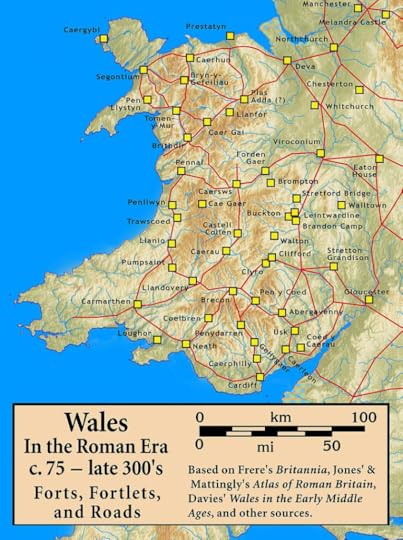 Wales in the Roman Era. Based on Frere’s Britannia, Jones’ & Mattingly’s Atlas of Roman Britain, Davies’ Wales in the Early Middle Ages, the Antonine Itinerary, and other sources (roads are incomplete; forts were built/abandoned over time) — sources are cited in the image legendThe topographical map is from a sub-region of File:Uk topo en.jpg, with the copyright notice {{Bild-GFDL-GMT|migration=relicense}} and original date of 7 July 2006, copy made in 2008, with the annotations removed by myself., CC BY-SA 3.0, https://commons.wikimedia.org/w/index.php?curid=11349765
Wales in the Roman Era. Based on Frere’s Britannia, Jones’ & Mattingly’s Atlas of Roman Britain, Davies’ Wales in the Early Middle Ages, the Antonine Itinerary, and other sources (roads are incomplete; forts were built/abandoned over time) — sources are cited in the image legendThe topographical map is from a sub-region of File:Uk topo en.jpg, with the copyright notice {{Bild-GFDL-GMT|migration=relicense}} and original date of 7 July 2006, copy made in 2008, with the annotations removed by myself., CC BY-SA 3.0, https://commons.wikimedia.org/w/index.php?curid=11349765A concept of collective ‘Welsh’ identity existed from the twelfth century, and you can read more about basic Welsh history and fun facts here. The oldest recorded use of the dragon to symbolise Wales (as opposed to just the Kingdom of Gwynedd?) is from the Historia Brittonum, written by the historian Nennius around 820, some two hundred years after the death of Cadwaladr when the political landscape had shifted dramatically following the invasions of the Saxons, Angles et al.
The Red Dragon came to have a certain legend attached to it, which would cement it as the symbol of the nation. The scene of the legend is Beddgelert (translation: Gelert’s Grave, so-called because of another, later legend, in which the dog dies. That’s very much the point. Gelert is the name of the dog.) Anyway, before Beddgelert was called that, the Red Dragon legend is set in that area.
This is largely the fault of Geoffrey of Monmouth, who recorded it in his Historia Regum Britanniae, written between 1120 and 1129. Geoffrey connects the Dragon to the Arthurian legends, and although Merlin (who has a life outside of Arthurian texts) is a South Welsh figure based in Carmarthen, he appears in the legend as a young boy brought to North Wales to solve the problem of Vortigern, whose new tower keeps falling down. Tired of constantly rebuilding the bastard thing, Vortigern asks the young seer why this keeps happening to it, and the young Merlin replies it is because he’s trying to build it above a subterranean cavern in which a red dragon is constantly fighting a white dragon. They take a look and let the dragons out, and the red one wins and flies away. Merlin explains that the red dragon symbolises the Welsh, and the white dragon symbolises the Saxons.
Why are the Saxons also represented by a dragon? Well, the rulers of Aberffraw were not the only ones to adopt this Roman legionary standard. There were other tribes, scattered across Wales and the rest of Britain, that used the draco too. The West Saxons (inhabiting Wessex) had the dragon as a symbol as well, and transferred it to Somerset, which today also has a dragon emblem.
Anyway, when the Saxons rocked up, they too adopted the same standard of the areas they settled in, and you ended up with battles in which both sides were fighting under the same emblem, which was understandably problematic. This is why the dragon worked in the legend for both parties, but as the Red Dragon of Cadwaladr was well established by the time Geoffrey was writing and the legend had been around a while, the Welsh dragon was red, and the Saxon dragon was white.
You can read the legend online here along with more posts on folklore and so on.
Fast forward to the Tudors, who themselves were an established Cambro-Norman dynasty. After complicated shenanigans during the Wars of the Roses, Harri Tudur (Henry Tudor, to give him his better-known English name) came out on top and Wales ended up judicially and administratively absorbed into England under his son, King Henry VIII. Henry VIII was responsible for adding the green and white to the Red Dragon banner, as those were the colours of his standard.
 Welsh Pride flag: Image from WalesOnline 2015, featuring Tony Wilkins and Martyn David at Rhondda Cynon Taff council offices in Clydach Vale
Welsh Pride flag: Image from WalesOnline 2015, featuring Tony Wilkins and Martyn David at Rhondda Cynon Taff council offices in Clydach ValeSo, basically, Wales is not a land of dragons in the sense that we have thousands of dragon myths and you trip over the little sods every time you go outside, it is a land of the or a dragon depending on the emphasis you give the legend, and this particular dragon, who most likely winged its way to Wales from what is now modern-day Iran or wherever via the Roman army in a much earlier form, and now represents the nation and the spirit of overcoming in whatever way you want it to.
Now, that’s not to say Wales doesn’t have OTHER dragon stories, more to say that the reason the symbol of Wales is a dragon is for political (and prophetic) reasons.
Further Reading:History Extra (requires a subscription)
Encyclopaedia Britannica entry on the Welsh Flag
The National : history of the Welsh flag
Llandeilo Graban, Powys – A dragon once nested in the belfry of the local church. From this lair it ravaged the neighbourhood until a blacksmith devised a plan to rid the area of the troublesome beast. He made a dragon out of iron and set it in the nest when the dragon was away. On returning, the dragon became enraged and attempted to remove the impostor, whereupon a mechanism was triggered which thrust sharp spikes into the creature, killing it.
Coed-y-Moch in Gwynedd was plagued by a wyvern, at one time, said to have been killed by the side of Llyn Cynwch.Welsh Borders
Interestingly, there are quite a few dragon stories from the borderlands, which includes Cheshire, Staffordshire, Shropshire, Herefordshire and Gloucestershire. These mainly take the forms of serpents, and appear in 18th and 19thC folklore collections.
You can read the article on them here.
Some of these tales include:
The Moston dragon, slain by Thomas VenablesDrakelow (Cheshire) where, like Warwickshire, the name implies a belief that a dragon slept in a barrow or mound, and there is a legend where one of the Anglo-Norman lords of Malpas slew a dragon (according to Alfred Ingham, Cheshire, its traditions and history, Edinburgh, 1920.)
The Mordiford dragon/wyvern, Herefordshire, raised from a tiny pup(?) by Maud of Mordiford, until it grew too big and she couldn’t control it (kind of a LAKE PLACID situation).
Bromfield, Shropshire: this is probably a con that went wrong. Thomas Walsingham’s chronicle has the following: ‘1344. Of a remarkable incident. In this year a Saracen doctor same to Earl Warren and asked permission to take captive a serpent, which he said was in a place called Brunfeld, on the Earl’s land somewhere in Wales. When this doctor had worked his charm and captured the serpent, he said there was a cave in the area where it had had its lair, and that this cave contained a great treasure. Some Hereford men heard about this. On the instigation of a Lombard called Peter the Picard, they went out there, began digging, and found out that the Saracen had been right. So they gathered together there for several nights, until the Earl’s retainers got wind of the matter; then the Hereford men were arrested and committed to prison. The Earl acquired a considerable treasure form this business.’ This sounds like there was never a serpent, but the serpent was a ruse to dig up the treasure (possibly a Roman coin hoard or other sort of archaeological thing. In Bromfield there are barrows as well as a Roman site).
Brinsop, Shropshire, another place where St George is meant to have killed the dragon, according to some local sources, but other versions of the tale simply reference a local knight who killed it at Dragon well.
Deerhurst, Gloucestershire: county historian Samuel Rudder, writing in 1799 and embellishing a little on Sir Robert Atkyns’s county history written in 1712, reported: ‘In the parish of Deerhurst, near Tewkesbury, a serpent of a prodigious bigness was a great grievance to all the country, by poisoning the inhabitants, and killing their cattle. The inhabitants petitioned the king and a proclamation was issued out, that whosoever should kill the serpent should enjoy an estate in the parish, which then belonged to the crown. One John Smith, a labourer, engaged in the enterprise. He put a quantity of milk in a place to which the serpent resorted, who gorged the whole, agreeable to expectation, and lay down to sleep in the sun, with his scales ruffled up. Seeing him in that situation, Smith advanced, and striking between the scales with his axe, took off his head.’ The milk detail appears to be added by Rudder and apparently does not appear in Atkyns.
There are more dragon/drake tales across these borderlands, and I would theorise this is because of the concentration of Norman influence here in what was a highly militarised zone. The Normans were Norse (their name is literally “the northmen”, or the “nor’men”), so their cultural tales of wyrms and dragons remained. In the poem Fouke le Fitz Warin, a fictional account of the local noble family the Fitz Warins (several of whom had the first name ‘Fulk’, and were conflated in the poem’s events), the eponymous character kills giants, and rounds off his adventures by slaying a dragon in Ireland (accompanied by the Earl of Chester, whose patrimony as we have seen is also riddled with dragon tales). Gaelic and Brythonic speaking peoples – what tend to be known collectively as ‘Celtic’ cultures – don’t tend to have early, pre-existing dragon myths of their own with the exception of Wales, looked at above. So again, this is an example of the dragon (and indeed, the giants earlier in the tale) being both from Norman tradition and wider European folklore, but also being politically symbolic within the tale, in this case in context of the Cambro-Norman invasion of Ireland. [The Normans intermarried with the local population wherever they invaded and settled in order to legitimately secure the land for their heirs, and so in this case became Anglo-Normans and Cambro-Normans when we’re discussing England and Wales post Conquest].
This is PART 1 of today’s mini-series of posts on dragons across the British Isles. PART 2 is on the North of England, Scotland and the Scottish Isles, so look out for that coming next! Leave me a tip on Ko-Fi if you want to 

May 6, 2022
#MonstrousMay Day 6: Monster in the Woods
 Prompt Credit: Johannes T. Evans
Prompt Credit: Johannes T. EvansInterlinking stories that build up a fragmented picture of what’s going on so far:
THE SMEECH MAN: read here or on Ko-Fi
THE ELEUSINIAN MYSTERIES: read here alone, or in this 99p collection
IT CAME FROM THE AMBER: read part of it here, in full on Ko-Fi
TW: imagery that may be triggering for trypophobia
Where did the broom go, with its sickly yellow, and the bluebell carpet, a thousand bells ringing silently?
What does the wind say when it forces the leaves to conspire, forging a transient sky-path for the canny to follow?
Where does the path lead, the track so familiar, the destination unsure? Why does the earth flow underground like water, and the air turn thick as a garden wall?
Why is the silence so loud today, cloud-grey muffling at maximum, nature suppressed by a strange suffocation, the application of invisible downward pressure?
Who’s there?
No one. Nothing. Real things make a sound, have a shape, can be touched. Touch should be two-way.
Something from a dream bored its way out, then bored back in. Something left a memory-hole, more than one, a honeycomb, a place to crawl in and out, from one waking to another.
Is this real?
Everything looks familiar, but it’s not. Where did the real things go, the textures of the trees, and why do they feel wrong today? Which waking is this? Is there another waking waiting beyond, at the end of the path, is that where the wind goes, is that where the wild things are?
There is nothing here. No sound, no life, no movement. Only the steady, slow suppression, the grey suffocation amid the green.
Who’s there?
No one. Someone. A prickle at the back of the neck. Nothing tangible, nothing visible, nothing more than a tickling, a crawling, a sensation over the skin that comes from oneself.
It’s not a man.
It’s too big for that.
And the sky is pressing, pressing, and the silence is loud, ringing, and the green is swallowing, consuming, and the path goes on forever.
Wake up now. Blink.
There is the yellow and the blue, the lilt of the birdsong, that feeling lifted. The path is the same, familiar, and nearly ended at the cheery gate of the cottage in the woods.
Do not look behind.
Do not blink again, or another hole might open up and there will be another waking, waking within waking, and there will be no more dreams, only an endless tunnel of green.
Do not ask. The green may answer. There is a monster in the green, in the holes, in the waking. There is a monster, and it has seen its way through. Beware the green dreams. Beware the green waking. Beware the Watcher in the woods.
May 5, 2022
#MonstrousMay Day 5: Werewolves
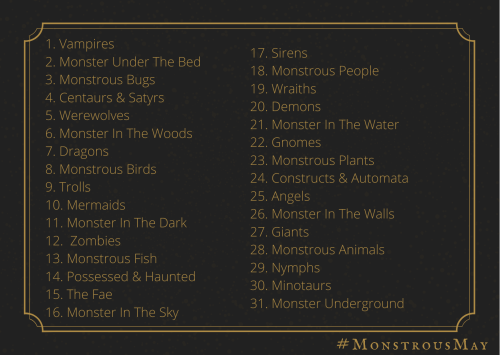 Creator: Johannes T. EvansExcerpt from Real Meat
Creator: Johannes T. EvansExcerpt from Real MeatThe story itself is not YA, but this section is from a teen’s POV just so I could explore the werewolf community through different perspectives. This led into the discovery of a body so we would then flick back to Tina Harris at the morgue. Tina appears as a side character in THE CROWS. I’m not sure if this will stay or not, whenever I get back to seriously working on this thriller.
Jessica Fielding had a special flair for the dramatic, when it suited her. She sat in her bedroom with the curtains closed against the raining April afternoon, headphones in, pretending she couldn’t hear the knocking on her door.
“Jess, Amy’s here,” her mum shouted through the door. “Jess, come on, love, come downstairs?”
Jessica screwed her eyes shut as the wolf-self came and went, clawing up her hands involuntarily and making fresh holes in her blanket. “I said NO, mum!”
“Sweetie,” her mother attempted, rapping again, “You can’t stay there all day. You didn’t even go out last night. It’s not healthy to cage yourself up at this age.”
“I’m fine, mum, stop fussing!” The wolf reared up, ending her sentence in a snarl.
“That doesn’t sound fine to me,” her mother replied, in tones that said she had heard it all before. “That sounds like someone hasn’t been staying up late enough or getting enough moonlight.” The door handle jiggled.
Jessica roared with frustration, leaping off the bed and slamming her full weight against the door and holding it shut. “Piss off!”
“What did you say?” The door flew open with a mighty crunch of splinters and old hinges, throwing Jessica back across the room, and Mrs Fielding towered in the broken doorway with bright amber eyes aflame. “You listen to me, young lady, you better high-tail it down those stairs in ten seconds and drop the attitude, or you’ll get to see the Big Bad Wolf, do you understand me?”
Jessica dropped to all fours on her sheepskin rug, hands clawing up, gnashing her flat ‘baby’ teeth, but her mother was having none of it, and strode into the room. “ONE.”
Foam formed in the corners of Jessica’s human mouth, but she knew she was beaten. She growled in her throat, but her mother leaned forwards showing all her teeth.
“TWO.”
Jessica huddled back against her chest of drawers, the silver charm accessories on her collar clicking together as they swayed.
“THREE. Do not make me get as far as five, Jessica Rose.”
Her middle name had the desired effect. Jessica stood up with bad grace in a sulk. “Alright! I’m going, I’m going. Don’t get your tail in a trap.”
“We never had this trouble with your sister,” her mother complained as Jessica marched down the landing. “She was always out until at least three in the morning, you could barely get her to stay in…”
“I’m out of my room, aren’t I?” Jessica snapped on the stairs. “Why are you punishing me?”
“I’m not punishing you, how am I punishing you? I’m just saying-“
“I’m out of my room, I’m doing what you wanted.” Jessica raised her hands, and clawed down the wallpaper. “See, there you go! Well done Jess, good wolf, Jess. How wolf-like of you, Jess.” She turned her back on her mother and took the stairs two at a time. “Reward the behaviour you want to see, mum, first rule of house-training. God.”
“No blasphemy in this house!” Her mother leaned over the rail, strident voice chasing her daughter out of the hall. “You’re not a blood-sucking heathen!”
“They excommunicate werewolves too, mum,” Jessica mumbled rebelliously, but her mother heard every word.
“That’s why we are good Protestants in this household, and don’t you forget it.”
Jessica pulled a face and stepped outside where Amy was waiting in unsuitable clothing for the changeable weather. She looked Jessica up and down, taking in the scruffy mousey-brown ponytail and baggy purple jumper with its rips and tears. “Where’ve you been?” she asked, twisting a strand of her straight blonde hair around her finger.
“What d’you want, Amy?” Jessica hovered by the front door, folding her arms.
Amy looked hurt. “What’s up, Jess? What’ve I done?”
Jessica swallowed, bouncing on the balls of her feet, sniffing the air. “Nothing. I don’t want to talk here.”
“Let’s go over the fields then.” Amy started off, light drizzle soaking through her frilly summer blouse. “It’s great weather, a bit of rain will make you feel tons better.”
Jessica followed slowly, the light rain soaking through her jumper and splashing down her cheeks, peppering her leggings with damp patches that merged slowly into one, coating her hair in fine droplets. As they came to the field, Amy shook out her own ponytail, releasing long wet hair to cling down her back. The rain was steady now, still not uncomfortably heavy, but not letting up any time soon. The grass brushed against Jessica’s bare ankles and soaked her canvas shoes.
“What’s up?” Amy asked again, brushing her shoulder against Jessica’s. “You can tell me.”
Jessica breathed in the comforting scent of wet grass and damp soil, the rhythmic patter of the droplets against her skin soothing and refreshing her. “Do you think it’s real?” she asked.
Amy twiddled a strand of hair. “What?”
“The curse.”
Amy stopped, but Jessica kept walking. “Of course not, Jess. It’s a stupid game, it’s not real.”
“But Grace is dead, isn’t she?” Jessica heard Amy drawing level to her in a few bounds, catching her up. “That’s not a game, is it?”
“That’s rubbish,” Amy protested. Her pewter wolfs-head necklace bounced against her chest, and she clutched at it like a talisman.
“Do you think the Loner really is cursed?”
“I don’t believe in curses.”
Jessica stared at her. “We’re sodding werewolves, you dipstick. How can you be an actual werewolf and not believe in curses?”
“It’s not a curse, my dad says it’s a genetic anomaly.” Amy tossed her hair back from her face, rain dripping from her forehead.
“Yeah, a genetic anomaly caused by a curse.” Jessica shook her head, sending droplets flying. “A genetic anomaly for normal people is like, I don’t know, having like two extra toes or something. It’s not turning into an actual wolf. You can live a normal nine-to-five life with a genetic anomaly, and have curfews at ten or eleven, not have to be out until three in the morning and have to spend your entire childhood wearing a stupid dog’s collar.” She tugged at the collar around her neck, and the silver charms stung and irritated her fingers as they connected. “Normal people can have genetic anomalies and scare their kids with the bogeyman,” she continued bitterly, pulling her hand away, “Not, ‘clean your teeth or the Loner will get you, who by the way, is a real person we don’t invite to pack socials because of how shit-scared we all are of her’. Normal people can have genetic anomalies and say stuff like, ‘break the law and you’ll go to jail’, not ‘break the law and the Loner will rip your spine out in front of everybody like she did to Mr Ferguson’.” She glared at Amy, squinting through the raindrops on her lashes, daring her to deny it. “I mean, who takes their ten year old kids to something like that? That should not be the defining memory of our childhood, know what I mean?”
Amy frowned. “Yeah, that was grim.”
“It was fucked up. But our parents took us along anyway, because – yeah, guess what, we’re cursed.”
“You can’t prove it’s a curse.”
“You can’t prove it isn’t.”
Amy glared. “Whatever. There isn’t a Loner Curse. There’s no such thing. That’s stupid.”
“Did your dad say so?” Jessica shot back.
“Don’t have a go at my dad, bitch! You just feel guilty.” Amy brushed against her shoulder with more force, making her stumble.
Jessica whirled, snapping, but only with her human jaws.
Amy danced out of reach, hands in her pockets. “It’s not our fault,” she said, and Jessica shook her head.
“You’re just saying that to make yourself feel better. You were all for it. I didn’t even want to, you were the one who turned the lights out, and shut me in there with the stupid mirror.”
“It was funny!” Amy protested. “Come on, Jess, you thought it was funny.”
“Yeah, right up until the Loner actually showed up at Grace’s fifteenth, and Grace actually died.”
“Months later!”
Jessica shook her head. “After her birthday party, her luck turned to shit. She didn’t even get on the work experience placement she wanted. Then she’s just – gone. And Hilda and her gran – they’re gone too. It’s like the whole First Pack is cursed. That’s what everyone’s saying, isn’t it? Jade won’t even speak to me. She’s ignoring my calls, she won’t answer my texts…”
“Who needs Third Pack friends?” Amy jogged after her, kicking a swathe through the longer grass. “Third Pack are losers. And the Loner’s not a bogeyman. She showed up the other night, asked some questions. I thought she’d be scarier in person.”
Jessica spun on her, horrified. “The Loner came here? Again?”
“Yeah.” Amy shrugged, affecting casual unconcern. “It was no big deal. She just wanted to know stuff about Mrs Parks, and Grace. She’s looking into it, Jess, so it can’t be her. Why would the Loner put a curse on the pack? That makes no sense.”
Jessica’s wolf-self reared, her eyes flaring a vibrant amber. “Shut up.”
“Don’t tell me to shut up.”
“No – Ames, I mean it. Shut up. Listen.”
Both girls stopped dead in the middle of the field, facing the curve of the trees.
“Someone in the woods? So what?”
“They sound hurt. Listen.”
The girls tried to pick out the sounds from below the light pattering of rain on the field. The noises faded away into an unnatural silence.
Amy sniffed the air, her eyes glowing a brilliant emerald green. “Hey, Jess? You smell that?”
Jessica sniffed too, inhaling the scent that came to them through the aromas of wet earth and grass. “What is that?”
“It smells amazing. Like a fresh kill. It’s not a deer, or a cow. What is that?”
“It smells delicious.” Jessica licked her lips, gulping the faint traces down. “Wow. I’ve never – smelled that before. Is it a pig?”
“No, not a pig.” Amy began stalking forwards, green eyes glowing, keeping her body low and tense with her knees bent, and arms tight to her sides. Her hands began to claw involuntarily. “It’s over here, in the trees there. Come on Jess! Do you smell that now? Like that, that, sweaty kind of smell around it?”
Jessica followed on cautiously, ears pricked for any further sounds, but there wasn’t anything. The sweat was less prominent as the raw, bloody, meaty smell, but it had a disturbingly familiar note, something that reminded her of the changing rooms in Pagham High School after a cross-country run. “I know that smell,” Jessica mused, salivating. “It smells kind of…”
“…human,” they said together.
May 4, 2022
#MonstrousMay Day 4: Centaurs & Satyrs
 Created by Johannes T. Evans
Created by Johannes T. EvansI’ve popped these recs over on Ko-Fi as well, please do check the TWs on them.
Recs for satyr horror (TW for rape):
THE VILLAGE IN THE WOODS (film 2019, dir. Raine McCormack)
I would personally give this… I don’t know. 5 or 6 out of 10. It was ok. Things I enjoyed:
The atmosphere: spooky village, car trouble, couple with a devious backstory, creepy locals who have lots of loud sex (also nice that they’re middle aged).The village gave me vibes from THE MONSTER CLUB (1981), specifically the ghoul story in that horror anthology, and also some strong CRONE WOOD (2016) vibes too.
I did think the ‘twist’ was inventive, which I’ve now kind of spoiled for you in that the locals are not human but have human forms, but that’s because I rarely see actual satyrs in British folk horror. BIG Arthur Machen vibes. There are lots of other plot points I’m not going to spoil, but TW for satyr rape, as I said, which is not so much an element as a whole ongoing theme, and is depicted both on-screen and off-screen (but you still hear the screaming). I did not enjoy that part.
Stuff I didn’t like so much/wasn’t for me:
I think I’ll have to re-watch it, because there was a bit of the plot I didn’t quite get. The whole reason the couple were there and how she got the ring was a bit involved and I think I was distracted and missed a crucial line that would have explained that to me. Also it’s been a few weeks since I saw it and now I just can’t remember a lot. So – it wasn’t that memorable for me overall, evidently, even though some bits have stuck in my mind.Genuinely found the whole reveal and the execution of the satyrs’ diabolical plans really disturbing, which could be a plus for some I guess. Another TW for intentional infanticide, not shown.
THE GREAT GOD PAN (novella by Arthur Machen) – my full review of it is here. I’ve reproduced the text of the review on Ko-Fi.
Things I haven’t personally read/watched but on my TBR/watch list for satyr horror:
DARK HOLLOW (novel by Brian Keene)
THE CENTAUR (short film 2015, dir. Aleksandra Niemczyk)
May 3, 2022
#MonstrousMay Day 3: Monstrous Bugs
 Prompt Credits: Johannes T. EvansIt Came From the AmberPart 1: Fragments
Prompt Credits: Johannes T. EvansIt Came From the AmberPart 1: FragmentsDiscovered in the papers stuffed inside Sir Peter Sauvant’s collection of journals, in the attic of Fairwood House.
[HALF THE PAPER TORN AWAY, WORDS MISSING]
—third day of excavation. This wasn’t the best start, but [PAPER TORN, WORDS MISSING]
—Conliffe. There should not have been fossils in the long barrow, but it might be supposed that the chieftains, wanting to be buried with something of rarity and beauty, found and polished these objects and brought them into the barrow to place in the walls.
Edgar prised one free. It is a sizeable thing. Deep honey in colour. A coil, or spiral, in shape, suggesting mollusc. It is pitted all around with darker circles, slightly concave. From these, it appears insects of some forgotten age are embedded. In some places, veined wings are visible. This suggests the mollusc, or horn, or organic matter, was pitted at some stage with small holes, and the insects nested inside. The outer coating of resin has preserved them entering and exiting this nest, although the holes are not visible.
[TOP OF THE NEXT PAGE TORN, WORDS MISSING]
—took some time, which was expected. Edgar has not been sleeping well and this is affecting his work.
Field Notes from Trench 3
[PARTIAL NOTES, a fragment of archaeological drawing]
Edgar has a strange theory about the pitted circles on the fossil – he believes it to be a primitive instrument of some type, and the circles are finger marks or notation of some kind. As for the bowls, they seem to have some ceremonial purpose. There were also discovered some sherds in Trench 2, and [PAGE TORN, WORDS MISSING]
—bowls. Sherds from Trench 1: suggested Romano-British date.
[DIFFERENT PAPER, SAME HANDWRITING, CRUMPLED UP, ASSUMED A DISCARDED DRAFT OF A LETTER]
[INKSTAIN]
—most concerned about Edgar. Between you and I, it would be better if he would have the doctor, but he will not go. We are all becoming concerned. I’m writing to you, not to worry you, but in the hopes that you might impress upon him the need for rest when he is home. A few days by the sea would be a tonic to his nerves. [NEXT PHRASES CROSSED OUT]
Part 2: Diary of Sir Peter Sauvant03 May 1892
The archaeological dig continues in Barrow Field despite the latest tragedy.
A few days ago, Edgar Halls unearthed a fossil, a kind of coiled spiral with fossilised insects in it, and it became something of a fixation for him. He tried to make sense of the thing as a primitive musical instrument, and then seemed plagued by strange sounds none of us could hear. He took it back to his lodgings without mine or Conliffe’s permission, and afterwards was most distracted.
Conliffe spoke to him on the morning it happened, and recalled Halls had a ‘faraway look’, and kept shaking his head, as if there was something bothering him. He kept humming a few notes, amelodic and strange, and complained of a terrible headache. We sent him home for some rest, and went to his lodgings at the White Horse to check on him later that day.
We found Halls in his room, ghastly grey-green, his eyes rolled up into his head and gripping the blankets so tightly he had torn them.
The only words we could make out were, “can’t control it” and “open the gate, open the gate,” which he repeated several times in increasing desperation. The doctor was called, and we held Halls down while he tried to assess him. Halls by then was raving. He could see things, he said, visions of some other world, things whispering to him in the fastness of space.
Halls opened his eyes only once during this, and that was to grasp at Conliffe’s arm in a terrible way, fighting off myself and the doctor to seize hold of our companion and nearly wrench his arm from its socket. Conliffe was forced to bend close, and I thought I heard a buzzing from the vicinity of Halls’ head as the man opened his mouth, slack and frothing.
He whispered something into Conliffe’s ear, then gave a terrible shriek, fell back onto the bed, and died.
Conliffe said nothing for several days. Eventually I pressed him on the matter of what Halls had said to him, those final words, in case any comfort might come from them to his mother and sister who reside, I believe, in King’s Lynn. Conliffe gave me a queer look, as though I had asked something obscene. I thought for a moment he was not going to tell me. Then, to my surprise, his countenance cleared and he said, in the most casual way which chilled me to the marrow, “Oh, all he said was the host was weak, and another should be found.”
“What could he possibly have meant by that?” I asked, incredulous, for I shudder to think what such words might mean.
“Well, I’m sure I don’t know,” Conliffe said with an easy shrug, but there was – there is – something about him now that I do not trust. “Some fancy or idea of his, I imagine.”
“Where could that have come from?” I mused, hoping to draw him out.
Conliffe said nothing for a while, then simply smiled and tipped his hat to me. “It came from the amber,” he said, and departed.
I have not seen that fossil since, and I am growing uneasy.
Tip me on Ko-Fi to read the full story!
May 1, 2022
#MonstrousMay 2: Monster Under the Bed
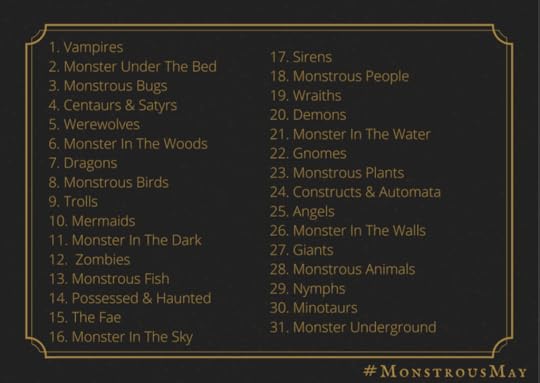 Credit: Johannes T. EvansThe Smeech ManI.
Credit: Johannes T. EvansThe Smeech ManI.The first night it was a light creak of the floorboards, nothing more. The quietest sound, the gentle breathing of wood as it cooled. It happened once, interrupting the lapping waves of sleep. He held his breath, listening. But there was nothing but his own heart and shallow breath, noises from his parents’ room that he recognised, and nothing more to hear. Except that he knew, from the way the silence thickened, that he was not alone in his room.
“There’s a monster under my bed,” Dickie told Belle the next day.
“You’re a liar,” she said, picking daisies. “You’re too old for stories like that.”
“I heard it.”
Belle looked up. “Mebbe tis the Smeech-man, summoned of a candle flame, come to steal your soul and fill your husk full of mist.”
“Did you do it?”
“Don’t be stupid. Why would I?” Belle gazed at him, her pretty face suddenly sly and mischievous, breaking into the cunning smile that made his heart skip. “Why would anyone?”
“You might’ve done it,” Dickie said, “Just to see if you can or not. Just to see if you’re a real witch.”
“Do you think I’m a witch?”
Dickie held out some flowers from behind his back. “I got these for you. For your May crown.”
“I might not be picked for Queen.” Belle put her head on one side. “Where did you get them?”
“Do you like them?”
“Did you steal them?”
Dickie shrugged. “They’re for you. What does it matter?”
“I won’t have you or your flowers,” Belle said primly, standing up and dusting off her smock. “Da says no first cousins.”
“And what do you say?”
Belle shook her head. “I’ll have none of you.”
Dickie burned red. “Who’ve you got your eye on, then? Is it Jack Martin from the farm?”
“None of your business,” Belle said. She glanced back at him as she walked away, daisies trailing from her fingers.
“He’ll have none of you,” Dickie shouted after her. “He won’t have you, Belle! I’ve seen things. Ask me! Ask me how I know!”
But Belle didn’t ask him, and she walked off humming something to herself.
Smeech Man, Smeech Man,
Candle light and leech man
Neath the bed, mind your head,
Smother you and make you dead–
The second night it was a light creak of the floorboards, and he held his breath as soon as he heard it. Something slid against the wood, shifting its weight on the boards. An inch, a short shuffle, lining up with his body as he lay on his lumpy mattress, under the loosening ropes that held it up against the frame. It had been his grandmother’s.
Dickie lay rigid in the dark, and couldn’t tell if he was sleeping or waking.
“It came back last night,” he told Belle.
“There’s no monster,” Belle said. “Stop bothering me, I’ve work to do and so have you.”
Dickie sat on the table in her way. “Done mine. You’re slow today.”
Belle looked prettiest with her hair all in a disarray from grate-blacking, smuts on her nose. She was prim and proper today, folding linen. He could see the curve of her chest better as she bent over, all covered with an apron.
“You shouldn’t be here,” she said.
“Got you roses,” he said, picturing her ankles and the turn of her calf under her long brown skirt. “You like roses.”
Belle arched an eyebrow at him. “I’ll have none of your roses, and none of you. Get out.” But she didn’t try and make him go.
Dickie swung his legs, scuffing the floor with the soles of his boots. “I’m telling you. There’s a monster. I can hear it at night. Moving.”
“And what I should care?”
“You know the story.” He poked at her linen pile to vex her. A stray hair of hers was caught in the folds. “It’ll come again tonight if I been witched. Eat me, lest I’m careful. Was it you witched me, Belle?”
“Why would I do that?”
“Sometimes I think you don’t like me.” Dickie put his head on one side. “Don’t you like me, Belle? Jack Martin has fancy words for a farmhand, but he’ll have none of you in the end. Ask me why. Ask me what I saw.”
Belle turned away. “You better go. Mother’ll box my ears if I don’t finish.”
He left the roses on the sideboard. “You’re better off taking me than Jack Martin.”
III.The third night, he heard it take a single breath. It was a short inhalation, a suck of air, a half-gasp. The boards creaked.
Dickie stared at the ceiling. There had been nothing under the bed when he jumped into it that night, he had checked. There was nothing to make that sound. There was nowhere it could have crawled from, no place it could have lurked, not without him seeing.
“Did you witch me, Belle?” he whispered.
His trembling hand pulled out a small matchbox from his lumpy pillow.
“Did you send something to scare me with?”
He slid the box open in the dark. A strand of Belle’s hair and a petal from a rose, a pinch of turf, a drop of his blood, the small bones of a chick, a pluck of bloodied down. A single match.
“Did you do it, Belle?” Dickie whispered.
Something below the bed moved. He felt it between the ropes suspending his mattress: a bulk, a solid mass, pushing up against his back.
Dickie struck the match and the contents of the box caught. Belle’s hair burned bright with a pinkish flame. His bed bucked beneath him as the bond broke.
Smeech Man, Smeech Man,
Candle light and leech man…
“Jack Martin,” Dickie whispered to the flame, feeling the pain of the thing beneath his bed. He sucked in the acrid smoke and puffed it out in a tiny ring. Say it once, and once again. “Jack Martin.” Third time’s the charm. “Jack Martin.”
He snapped the matchbox shut and the flames went out.
Dickie was alone.
He smiled to himself. Jack Martin could take his chances with the Smeech Man now.
“Let’s see how brave you are, Jack Martin,” Dickie murmured to himself. He grinned, and fell peacefully asleep.
#MonstrousMay 1: Vampires
I’m re-posting two vampire vignettes from last year, as I’m not that into vampires at the moment and I want to spend some time on other prompts. So some golden oldies to kick off with!
My nonfiction post on Welsh folklore and vampires can be found here.
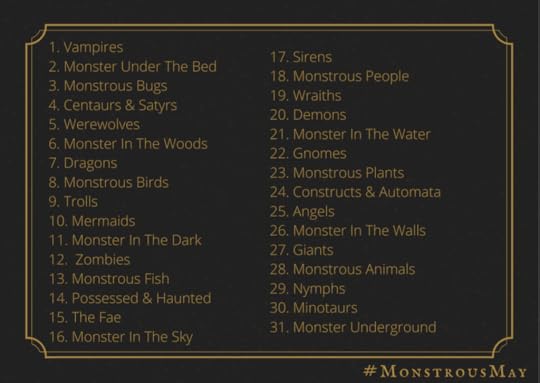 Credit: Johannes T. EvansMidnight at the Crazy Golf
Credit: Johannes T. EvansMidnight at the Crazy GolfIt is midnight at the crazy golf in Pagham-on-Sea, where the cream-and-pink curls of candyfloss pillars welcome the late-night revellers with their pale, bloodless faces and radiant, ruddy smiles. The lamp of the moon and the orbs of the string-lights pick out the path past the greens bathed in silver, wending in and out of a miniature landscape of windmills and other wonders.
It is midnight at the crazy golf in Pagham-on-Sea, where a pair of putters share first-date smiles, sipping alternately from a cool iron-rich beverage through a single red-and-white straw. One takes a stand and angles the shot – there is some fumbling of their cold, stiff hands, coffin-numb fingers gripping the putter, taking advice as if they have never played the game. The other smiles – they have not played for twenty years, they say, but it will come back to them. The ball bounces off the side and up the slope, a perfect shot. The first opens their mouth, circular, ringed with tiny translucent teeth, a sign of excitement on their otherwise placid, featureless face. A hole in one.
It is midnight at the crazy golf in Pagham-on-Sea, where at the second hole stands a butler who has not buttled for two centuries and misses the days of the big house, and tells the ball so. He tells the ball everything because he has brought it with him, and his own silver club, which he wields with efficiency but keeps his white gloves on. He tells the ball where to go, and whispers to the streak of quicksilver as it arcs in the moonlight, imparting secrets of a life he once lived. “And I told the maid,” he says, in the middle of a story, “But she didn’t understand, you see.” The ball rolls towards the hole, and he meticulously jots down par.
Trails of silly string clog the windmill sails on the third hole, a confectionary palette of blue and chamomile-yellow. It is no one’s business what is happening on the miniature bridge. The shadows cover the scene and a small shoe lies discarded near the shallow water course. It is midnight at the crazy golf in Pagham-on-Sea, and drifting, silent figures thread across the worn AstroTurf with pencils and scorecards. It is no one’s business what is happening beyond the fifth hole, either, and the sounds are swiftly stifled, so nobody minds.
The second hand of the oversized clock on the steeple trembles. The booth is manned but the sign says No Entry – it is midnight and the crazy golf is full. The night shift consists of a boy behind bullet proof glass, his collar drawn high around his throat and he is reading a book. He is pale, washed out, making every effort to appear bloodless. Perhaps he is, but he is still flesh. In the booth is everything he needs – a small toilet and basin behind a folding door, a fridge and a panic button. He makes no unnecessary movements. He breathes as shallowly as he can.
It is midnight at the crazy golf and the course is teeming with patrons, but the boy in the booth is the only one whose lungs are full of air. He knows better than to step outside, to listen too carefully, to take out his earbuds.
It is midnight at the crazy golf and the green is alive with unheard stories, and the shambles of the dead.
Interview with a VampireThere is no right way to be a vampire. Kids today think that it’s all a matter of befriending butchers or locking yourself in your room, becoming a pale shut-in who cannot be trusted not to rip someone’s throat out. And, all right, for some that’s all part of it. You can do it that way. Films and shows tend – apart from a few franchises, which go a bit far the other way – to depict the vampire as solitary, individualistic. Again, not a wrong way to be a vampire. But loneliness is not something to be encouraged or celebrated. It eats you like a cancer.
Personally, I dislike loneliness more than I dislike other vampires, and that’s why I honeycomb rather than nest.
What’s the difference? Well, a nest is the way it sounds, cheek-by-jowl, that sort of thing. A load of corpses swinging from the rafters and/or solid home gym equipment, the floor littered with blood clots that get coughed up looking like splats of black pudding. It’s what happens when you hang upside down.
Honeycombing is similar, but you get your own space. Coffin-sleepers are honeycombers by default, with their caskets laid out over the floor or stacked on solid bunk bed frames like a backpackers’ dorm.
Of course, either way, they might ask you what type you are.
Not blood type. Type type. You know.
As in, what bit you. Could be a who, of course, but then the question is less likely to come up, since presumably they’ll be around to tell the others themselves, and it should be fairly obvious. Unless you’re alone, and then your tale will probably be a sad one. Anyway, you could point out your progenitor, and the question would still be repeated.
Yes, but what’s your type?
Did your hair fall out as it took hold, or did it grow? Did your eyes become increasingly photosensitive? Did your pupils dilate? Did you start to bleed, or suspect an STI? Did your brain function alter? Did you have strange dreams of a past that wasn’t yours, did your short-term memory fail and your concentration jump like a live-wire? Was there ooze? Was there pain? Did your teeth fall out or did new ones push through in front? Did you lose your toenails, was there rot? Do you burn in the sun, or is your skin tougher now? Can you shapeshift?
And you will describe your symptoms and they will name a type, and either they know what they’re talking about or you will be forced to smile.
No, you’ll have to explain. While those symptoms do overlap with that type, that’s not quite what I am. You see, it’s like any infection – how it takes you depends on things like your blood type, your metabolism, your build, whether you have underlying health conditions. Sometimes it tears through you and leaves you a husk, and sometimes it takes you slower, but it’s all the same thing.
This is what I am. I have a card.
Yes, I know I don’t look that way.
In fairness I’m not surprised you haven’t heard of someone like me being that type, this particular symptom is a very rare side effect – it’s why we are often mis-typed. I usually use it to my advantage, because everyone is so surprised that allieae don’t affect me. (That’s the classification to which alliums belong, of which garlic is one).
You’ll get bored of saying it. I got bored of saying it. Everyone gets bored of saying it. That’s why I carry a card. You’d think people would get bored of asking, but that’s never the case. It’s far more interesting to ask than it is to tell, after all.
You don’t have to have a card.
You might not want to carry one, and that’s alright. It’s riskier for the donors if they have to take it on trust, but a lot of people are into the risk. They queue up for it, especially if you know where to hang out, where the defanged ones lurk with their bloody gums. You know about defanging?
Yes, it’s what it sounds like. Too many warnings about your conduct and the elder ones will rip your teeth out by the roots, and your fingernails from their beds. You’ll have to learn how to use blades, syringes, anything sharp and quick. You’ll have to wait for everything to grow back, and suffer. They’re like rats, the defanged ones. Scurrying in alleyways, crawling up the walls away from patches of light. They become scavengers and second-hand feeders, following bigger predators at a safe distance in a feral shoal.
Don’t let them take your teeth.
It’s not tyranny. It’s sense. If you nest or honeycomb, you’re following the rules, like any lodger or tenant. You don’t have to do either – I told you at the start, there’s no right way. You can be solitary, find your own place. Keep the one you had while you were alive, block the windows with cardboard and blackout blinds, change the locks and wait for the neighbours to stop being nosy. Befriend a butcher like they do in the movies. Why not? There’s no right way.
But if you make trouble for the nests, they’ll come down on you with apocalyptic fervour.
Make yourself useful to them, and you can stay fed.
You’ll get used to it.

April 26, 2022
#MonstrousMay 2022
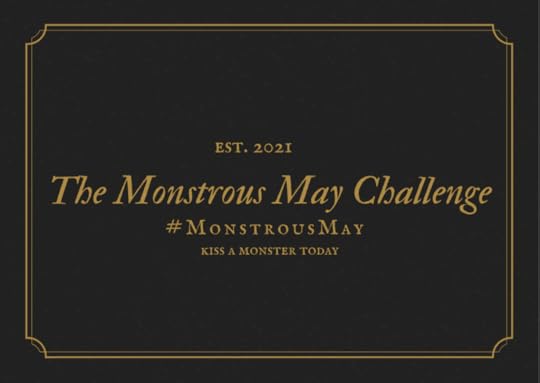 Graphic credit: Johannes T. Evans
Graphic credit: Johannes T. EvansLast year, Johannes T. Evans (whom I interviewed on the podcast for Queer Monster Hour) inaugurated #MonstrousMay for all kinds of creators to get involved with. It doesn’t matter what you create or in what medium, you can join in and interpret the prompts however you want.
Every day through May is a new prompt. His full post is here.
Tag your prompts #MonstrousMay – you can follow Johannes, the creator of the tag and prompts, on Twitter, Medium, Patreon and Ko-Fi. His usual content is 18+ only!
 Creator: Johannes T. Evans, erotica writer and comedianPrompts ~ Accessible ListVampiresMonster Under the BedMonstrous BugsCentaurs & SatyrsWerewolvesMonster in the WoodsDragonsMonstrous BirdsTrollsMermaidsMonster in the DarkZombiesMonstrous FishPossessed & HauntedThe FaeMonster in the SkySirensMonstrous PeopleWraithsDemonsMonster in the WaterGnomesMonstrous PlantsConstructs & AutomataAngelsMonster in the WallsGiantsMonstrous AnimalsNymphsMinotaursMonster Underground
Creator: Johannes T. Evans, erotica writer and comedianPrompts ~ Accessible ListVampiresMonster Under the BedMonstrous BugsCentaurs & SatyrsWerewolvesMonster in the WoodsDragonsMonstrous BirdsTrollsMermaidsMonster in the DarkZombiesMonstrous FishPossessed & HauntedThe FaeMonster in the SkySirensMonstrous PeopleWraithsDemonsMonster in the WaterGnomesMonstrous PlantsConstructs & AutomataAngelsMonster in the WallsGiantsMonstrous AnimalsNymphsMinotaursMonster UndergroundI’m looking forward to this and I will try to join in with some short fiction!



